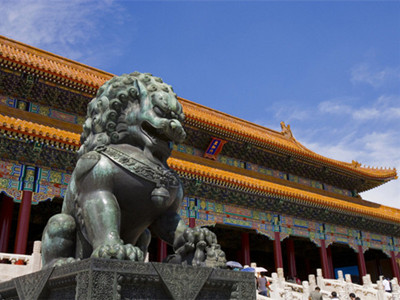Forbidden City [ Related Itinerary ]
 Visit the Forbidden City is to review the history of China’s Feudal Society. Nearly rivaling the iconic status of the Great Wall, Forbidden City is an absolute must see for any Beijing traveler.
Visit the Forbidden City is to review the history of China’s Feudal Society. Nearly rivaling the iconic status of the Great Wall, Forbidden City is an absolute must see for any Beijing traveler.Forbidden City served as the home of 24 emperors and his family (14 in the Ming Dynasty and 10 in the Qing Dynasty) as well as the ceremonial and political center of Chinese government for almost 500 years. The massive collection of over 8,700 rooms is one of the most historic sites in old Beijing and is a perfect example of classical Ming architecture.
Main Architectures in Forbidden City
Forbidden City is surrounded by a 10 - meter - high wall, and further encircled by a 52 meter wide, 3,800 meter long moat. There are four gates on the wall, each with a tower above them and on the four corners of the wall stand four turret towers (each with three roofs and 72 roof ridges).
Based on its layout and function, Forbidden City is divided into two parts - the "Outer Curt" and "Inner Court", which is bounded by Gate of Heavenly Purity (Qianqingmen).
Outer Court
The Outer Court was where the emperor exercised his supreme power over the nation including Three Main Halls - Hall of Supreme Harmony, Hall of Central Harmony, Hall of Preserving Harmony
Hall of Supreme Harmony, the Throne Hall, was built in 1420. It is the largest wooden structure still standing in China. It was used for grand ceremonies such as the celebration of Winter Solstice, the Chinese New Year, the Emperor’s birthday and ascension to the throne and the dispatch of generals to battles.
Hall of Central Harmony is the smallest hall among "the Big Threes" in the Outer Court. The emperors came here once a year to perform ceremonies like examining seeds for sowing, to take a rest before dressing up for great ceremonies in the Hall of Supreme Harmony, to receive ministers and greet foreign envoys or to deliver speeches to the royal family.
Hall of Preserving Harmony was the last hall of the Outer Court. In 1789, the hall became the site of the "Palace Examinations", the highest level of the nationwide imperial examination system. This hall was the most decorative of all the halls, and the great imperial banquets were held here.
Inner Court
The Inner Court was where the emperor lived with his royal family. At the center of the Inner Court is another set of three halls - the Palace of Heavenly Purity, Hall of Union and the Palace of Earthly Tranquility. Then there are Six Western Palaces and Six Eastern Palaces where the concubines and the children of the emperor's lived. Behind these halls lies the Imperial Garden. Here is the best place for the royal family to relax, where contains several elaborate landscaping features.
As the symbol attraction located in the heart zone of Beijing, Forbidden City is really worth a visit for first time visitors to Beijing!
Related Itinerary